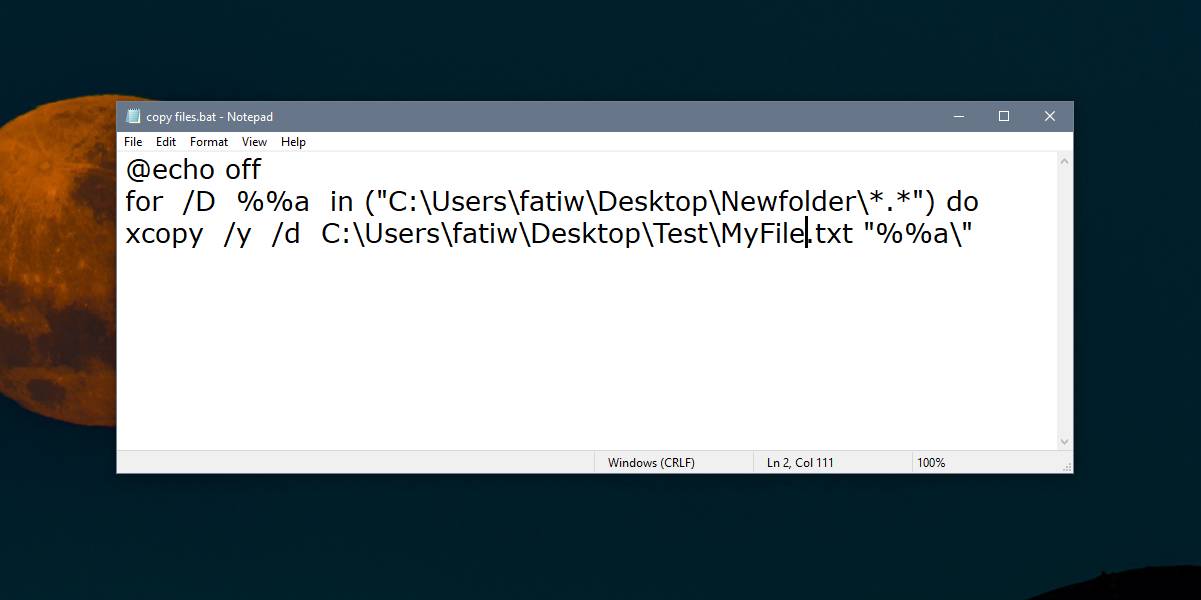
- #Batch script example run filess how to#
- #Batch script example run filess full#
- #Batch script example run filess windows#
Window from automatically closing should my script, or a called script, call the EXIT command. The reason I do this is to keep the command prompt The /D disables any auto-run scripts (this is optional, but, I use auto-run scripts). The /C option instructs the child process to quit when your script quits. This runs your script in a new command prompt child process. %COMPSPEC% /C /D "C:\Users\User\SomeScriptPath.cmd" Arg1 Arg2 Arg3
#Batch script example run filess full#
The command prompt will enter the full path to your script on theĬommand line, and will quote any paths containing spaces. Run your script is to drag and drop the script into a command prompt window. For newbies, I think the easiest foolproof way to When editing a new script, you will likely need to run the batch file in an existing command window.
#Batch script example run filess how to#
(We will learn how to handle this problem in Part 10 – Advanced Tricks ). The command prompt window for the script will disappear as soon as the script exits. Unfortunately, the command prompt will not give you much of a chance to see the output and any errors.
#Batch script example run filess windows#
The easy way to run your batch file in Windows is to just double click the batch file in Windows Explorer (aka “My Computer”). HelloWorld.cmd in a new command prompt without changing directories beforehand or needing to specify the path to the script. Saves a little bit of time because a new command prompt will generally default the “working directory” to your user profile folder. On newer Windows systems, your user profile folder will typically be C:\Users\. The %USERPROFILE% keyword is the Windows environmental variable for the full path I’ve saved the file to my “user profile folder” by naming SIDEBAR: I’ve used a shortcut in this screenshot that you will learn more about later. See the screenshot below for an example of saving a script named “HelloWorld.cmd” in Notepad. cmd extension, you will need to change the “Save as type” to “All Files (. Notepad by default tries to save all files as plain jane text files. Of course, there could be a very unique circumstance in which you want to modify the default behavior of ping in which this naming suggestion would not apply. (Stay tuned for how this could happen.) I might called the script RemoteHeartbeat.cmd or something similar to add some context to the script’s name and also avoid any naming collisions with any other executable files. Things might get very confusing if you try to run ping and inadvertently call ping.cmd when you really wanted ping.cmd. For example, I would avoid naming a script ping.cmd since there is a widely used system binary named ping.exe. , Hello-World.cmd, Hello_World.cmd).Īnother thing with names to consider is avoiding names that use the same name of any built-in commands, system binaries, or popular programs. You can also use punctuation characters like. Pascal casing your filenames is an easy way to avoid spaces (e.g., HelloWorld.cmd instead of Hello World.cmd).

I recommend avoiding spaces in filenames, as spaces only create headaches in shell scripting. cmd file extension, you can use just about filename you like. cmd to avoid some rare side effects with. bat, though I recommend sticking with the more modern. Some seriously outdated Windows versions used. If you need to view the contents within a command prompt window itself, you can use a DOS command like TYPE myscript.cmd or MORE myscript.cmd or EDIT myscript.cmd Batch File Names and File ExtensionsĪssuming you are using Windows XP or newer, I recommend saving your batch files with the file extension. In Windows Explorer (aka, “My Computer”), you should be able to view a batch file in Notepad by right clicking the file and seleting Edit from the context menu. I would stick with Notepad for viewing the contents of a batch file. Very few editors do anything special for Batch files like syntax highlighting or keyword support, so notepad is good enough fine and will likely be installed on just about every Windows system you encounter. Since batch files are just ASCII text, you can probably use just about any text editor or word processor.

The universal text editor for batch files is Notepad ( Windows Logo Key + R > Type notepad then Enter). This is way faster than navigating the Windows Start Menu to find the Command Prompt. Windows gurus launch the command prompt using the keyboard shortcut Windows Logo Key+ R (i.e., “Run”) > Type cmd.exe then Enter. The best shell scripting langauge, but, it gets the job done. The tools come out of the box: the Windows command prompt and a text editor like Notepad.exe.

You can create and modify batch scripts on just about any modern Windows machine. Windows batch scripting is incredibly accessible – it works on just about any modern Windows machine. Getting Started with Windows Batch Scripting


 0 kommentar(er)
0 kommentar(er)
